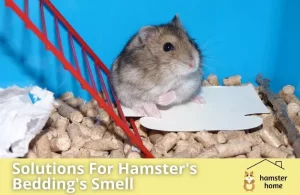How often you should clean a hamster’s cage and accessories – The number of times you should clean your hamster’s cage depends upon many things. These include how big your hamster’s cage is, how many hamsters are sharing the cage, how quickly it gets dirty, etc. Ideally, you should clean your hamster’s cage and accessories every week with spot-cleaning daily.
Keeping your hamster’s cage is crucial as his surroundings play a significant role in his overall health. Continue reading to learn how to clean your hamster’s cage without stressing him.
How To Clean A Hamster’s Cage?
Most new hamster owners pay a lot of attention to the feeding routine of the hamsters but completely ignore cleaning. Now you understand that cleaning your hamster’s cage is important. So, you should also understand how to clean it. Because if you don’t do it the right way, it will make your hamster uncomfortable with the cleaning routine.
Any disturbance in the normal routine can create stress for your hamster, making him sick. You can avoid this only if you know how to clean your hamster’s cage without disturbing him.
Here we explain the cleaning process for your hamster’s cage in an easy-to-understand way.
Things You’ll Need For Cleaning
Before you start cleaning the cage, make sure you have the following things:
- Cleaning agents, for example, dish soap, diluted apple cider vinegar, or any gentle cleanser.
- Washcloths, if you don’t have these, you can also use paper towels.
- Hamster’s bedding, some of the best options include toilet paper, recycled paper, and kitchen roll.
Steps For Cleaning Your Hamster’s Cage
Follow this step-by-step guide to clean your hamster’s cage without harming your little hamster:
1. Get Your Hamster Out Of The Cage
To clean your hamster’s cage, you first have to put your hamster in a safe place. Remove him from the cage and keep him at a place where he will be safe. You can keep your hamster busy with his favorite treat or toy.
Whatever you provide any accessories to your hamster to stay busy, always remember to watch him. If he is playing while you are cleaning, ensure that he doesn’t harm himself with anything. If he is eating, don’t forget to check that he only eats stuff that is safe and healthy for him.
Cleaning your hamster’s cage can do more harm than good for your pet without these safety measures.
2. Remove Everything From Your Hamster’s Cage
Remove everything from your hamster’s cage, including toys, food bowls, bedding, and housing. Used bedding should be discarded when you clean the hamster’s cage. There is no point in putting back dirty smelly bedding in a clean cage.
Besides this, other things can be used again after they have been cleaned properly.
3. Clean The Cage Thoroughly
Begin with spraying the cleaning agent in the cage. Scrub the cleanser with a cloth or paper towel to remove the stains or droppings. Once you’ve cleaned the cage, clean your hamster’s toys, food bowls, and other things before keeping them in the cage.
When you’re done, dry everything, including the cage, with a towel. Replace the old bedding with a new one. You can consider changing the position of some things that will work as a healthy change for your hamster.
4. Put Your Hamster Back In The Cage
Put your hamster in the cage again once everything is completely dry. If you change the position of things, such as bedding or food bowls, in the cage, make sure to check your hamster for some time. Observe if he likes the change or not. If you feel that your hamster is finding it hard to adjust to the change, don’t delay bringing the things back to their old location in the cage.
Spot-Cleaning Hamster’s Cage: What Does It Mean and Why It’s Important?
Spot cleaning refers to the process of cleaning the dirtiest areas in your hamster’s cage. It’s important as it keeps your hamster’s cage clean for longer. You can do this by cleaning the toilet areas of your hamster’s cage, removing the uneaten food, or changing the bedding often.
FAQs
Here are some questions related to cleaning a hamster’s cage that will help you in the process:
Antibacterial soaps are preferred cleaning agents. They are not harsh and hard to rinse, unlike disinfectants. So, you should use antibacterial soaps for regular cleaning of your hamster’s cage. However, in some cases, you have to deeply clean your hamster’s cage when your hamster is ill or passes away. In such cases, you’ll have to use a disinfectant as it’s a stronger cleaning agent for removing all the germs.
Your hamster stays in his cage most of the time. He will eat, sleep, drink, or pee in the cage. The food particles or the water drops that fall in the cage can create a smell and make his cage dirty. The basic reason is, however, your hamster’s urine. If your hamster is trained, he’ll urine at a specific place in the cage, making cleaning easy. But, if not, then be prepared to clean the whole cage as required.
Yes, white vinegar is safe for cleaning your hamster’s cage. But, after cleaning, allow the vinegar to dry before you put your hamster in the cage. White vinegar has a strong smell that can irritate your hamster and make him sick.
Conclusion
With a proper hamster’s cage cleaning routine, you can protect your little furry buddy from many common health issues. All you have to do is be a bit more observant. If you find anything is making your hamster’s cage dirty, clean it if possible or replace it with a new one. If done on time, these small things can create a big difference in making your hamster active and healthy!






